S L Fashions Women's Black Dress Rhinestones Shoulders
Breaking gratuitous from the tailored look on the 1950s, the youthquake driven dresses of the sixties loosed upwardly the waistline, shorted the hemline and hit you smack in the face with bright Popular Art colors and Op Art (optical illusion) prints. 1960s dresses had multiple style variations off of one key shape- the shift apparel. From there, a new decade of dress designs began to experiment with waistline placements, sleeve shapes, colors, and patterns.
Follow along as I show you all the 60s dress styles worn by real people in the 1960s (more often than not American, but these styles apply to all western dress).
1960s Dress Styles
Swing Dresses
The full brim and tight bodice of the '50s swing dress continued in the early on '60s, with a slightly above or at the knee joint hemline and modest high necklines. 60s swing clothes colors and patterns were bigger and brighter with high necklines and short cap sleeves or the new-ish 3/four sleeve. Round collarless necklines, small Peter Pan collars, whorl cervix collars, and the broad portrait collar were frequently seen on swing dress tops.
1960s dress skirts became less full, requiring only a skid instead of crinoline petticoat as the decade moved on. Big box pleating made some skirts look fuller. Jackie Kennedy was seen wearing a box pleat swing brim with bow belt, which became very trendy for a few years.
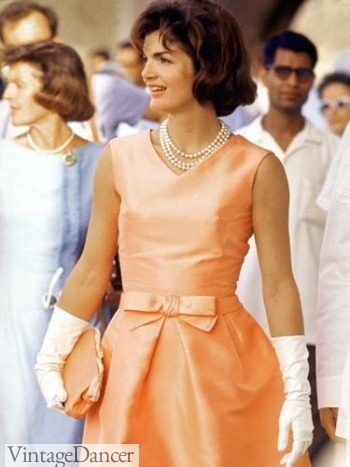
Jackie O – so swish!
By 1965 the swing dress nigh disappeared, merely to come back over again in 1969 with a mini brim length.
Shirtwaist Dress – Housewife Dress
Most swing dresses in the 1960s were deemed house dresses or housewife dresses, especially in the shirtwaist design. Shirtwaist dresses that buttoned downwards the front end from neck to waist, mid way downwardly the skirt, or all the way to the hemline had been traditional business firm dresses since the 1920s. Plaid, checks, gingham, and vertical stripes were very popular patterns. Shirtwaist dresses had classic betoken collars or the newer round Peter Pan collar.
At some betoken the "waist" part of shirtwaist was dropped and they merely became know as "shirt dresses." Shop shirt waist or shirt dresses in vintage styles.
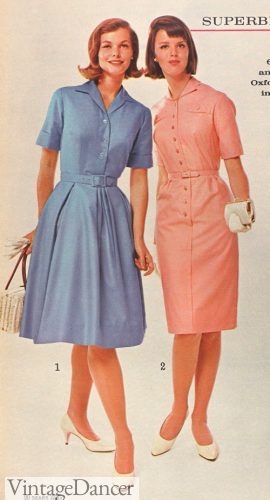
1964 shirtwaist swing and pencil dresses
By the mid 60s the shirtwaist wearing apparel was updated into the "step in" shirtwaist apparel which was a button down skimmer clothes tightened with an optional thin tie belt.
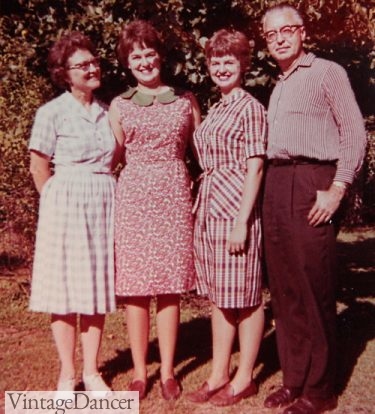
My family in the early 60s (grandma, aunt, mom, grandad)
Smock Dresses
The smock top skimmer apparel with a line to a higher place the bust and sometimes "smocking" or shirred details was another belatedly 60s house clothes design. These adorable dresses were inspired by cornball prairie life/One-time West/ frontier days but with the short 60s hemline. They were mostly seen on women'due south firm dresses but some designers made them work equally political party dresses. They were not very popular however, and the trend apace faded.
Advertiser
Shift, Sheath, Skimmer, Tent Dresses
The other 50s to 60s wearing apparel carry over was the contoured sheath dress, called a pencil or wiggle dress today. Like the 50s version, it was knee-length, modest, and minimalist only gently tailored to the hourglass curve of the body. Knit fabrics were the all-time materials to use in the 1960s so that women could take the "jerk apparel" shape without the confines of potent suiting.
The 1960s two slice sheath dress looked like a fitted jacket with a pencil skirt. It was a very classy! As the sheath dress loosened up into the shift clothes the 2 slice dress followed with a brusque sleeve trounce top and looser pencil skirt.
The 60s shift dress lacked any sort of tailored waistline but did pinch in slightly around the ribs and skimmed over the hips, catastrophe slightly to a higher place the knee. Some had belts, most did not. This loose but narrow looking dress was very comfortable and easy to wear. The shift became the main women'due south wearing apparel style of the 1960s.
Skimmer dresses were a cousin of the shift wearing apparel. They fit straight on the trunk with a high neckline and minimal ornamentation. The dress "skimmed" the body without touching the skin. They also hovered above the genu. The ruffle front skimmer was very trendy between 1968-1970.
Shift, sheath, and skimmer dresses were used interchangeably in sixties advertising, calculation some defoliation to dress style names.
The tent wearing apparel was the widest fitting loose dress. Later decades called it a babydoll or swing dress (not the aforementioned equally an early 60s swing wearing apparel). Pleats handing from the neckline or shoulders down in a wide A-line gave the clothes movement, hence the "swing" name. The broad flare and the bowtie at the neck or bust miniaturized young women, making them look like dolls instead of grown women.
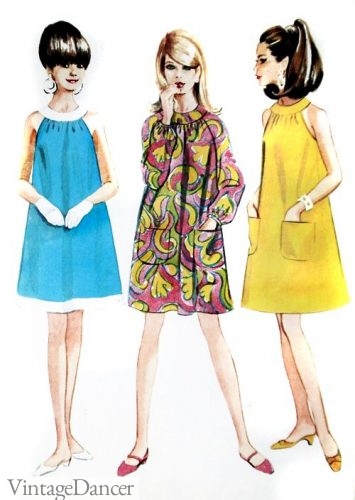
1966 tent dresses
1960s Waistline Dresses
The 1960s has some unique waistline treatments that were revivals from earlier decades, primarily the 1920s.
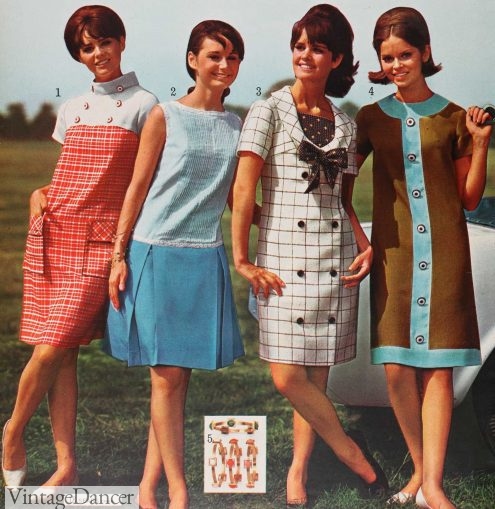
1966 dresses: Skimmer, A-line, Coachman, Shift Dresses
The A-line dress, like the other shapeless 60s dress above, had a relaxed fit up summit but a A shaped flared skirt below. It could exist one color simply often had a dissimilar blueprint or colour acme and bottom making it look like a skirt set. Paired with a drop waist it was a 60s "young wait" dress.
Other drop waist dresses had pleated skirts to mimic the A-line flare. They were a favorite with immature and mature women, merely mature women's pleated skirt dresses look like those from the 1940s.
Instead of the low drop waist there was as well a revival for the high empire waist dress. The dress top cut of just below the breasts and skimmed over the trunk. Sometimes a drawstring necktie made the empire outcome – a very beautiful and charming "girly" detail.
The coachman clothes was an updated name for the coat and wearing apparel. It could have a sheath or shift dress shape topped with a double row of either decorative or functional vertical buttons.
Jumper or Pinafore Dress
Going with the "fiddling daughter" expect of the 1960s, the jumper apparel or pinafore clothes was worn past girls, teens, and some women. At that place were several neckline treatments from the high and modest shift apparel to the V neck sheath dress and the very late 60s deep U shaped jumper dress. They were a coincidental wintertime dress worn over a blouse or turtleneck shirt, ordinarily white or cream, sometimes black.
Summer Dresses
Coulotte Dress
The Coulotte short pant was a trendy mode for summer. With a fitted tiptop and extra broad legs, the Coulotte looked like a dress. They fit more into the "playwear" or summer "sporty" looks rather than clothes wearable, merely the cantankerous-over was noticeable. Many business firm dresses adopted the comfy Coulotte likewise equally summer holiday clothes.
The nautical or sailor theme had been and remains to exist a popular summer trend. Ruby, bluish and white stripes with sailboat, nautical flags, anchor motifs, accented past brass buttons, white "crewman" collars, and polka dot neck scarves. They fabricated their way onto all kinds of summertime clothing and dresses from casual to classy. Taking a vacation or sailing on a cruise almost required women to purchase these outfits.
Shop vintage sailor / nautical outfits.
Sunday Dresses
At the terminate of the decade, immature women and teens started wearing sleeveless sundresses. The lack of sleeves wasn't a new matter to 60s fashion, simply the spaghetti straps were. Add to it a built in bra (for B loving cup sizes) and you have a fun beach-y casual summer clothes. For those not quite fix to testify off that much cleavage, there were other slip-over lightweight summer dresses in festive prints.
Stripe Knits
Vertical stripes had been mutual in all parts of the 1960s but horizontal stripes, especially in bold mod colors and jersey knit fabrics, were the trendiest look for teens and young women with the body to pull them off. They were casual 60s dresses, comfortable in almost any atmospheric condition, and well-nigh important to the sixties, FUN!
Hostess Wearing apparel
What well-nigh long dresses? Were all dresses in the 1960s short?
Yes and no. Nearly all women's dresses were at or above the human knee. Women wore tights or tall socks to shell the cold, simply style was fashion and fashion said no long dresses! There was one exception. The hostess gown.
In the late 1950s and early on 1960s, party dresses were separate down the middle brim and worn over a pair of capri or long pants becoming a hostess gown. In the belatedly 1960s, a revival of the hostess gown idea happened, combining the long house robe with an ethnic dashiki or caftan inspired tunic dress. Indigenous inspired prints, large florals, geometric patterns, and psychedelic swirls splattered across these unusual gowns. They were considered a novelty and few regular women adopted only in wealthy and famous circles they thing to habiliment at lavish house parties… or merely to lounge at habitation in.
1960s Dress Colors and Patterns
Gingham Checks
Brigitte Bardot wore a pink gingham wedding apparel with white lace trim in 1959 . After that, pink gingham was used for all kinds of dresses. Other pastel gingham colors such as purple, blue, yellow, and green were also trendy only not most equally cute as pink. White lace or rick rack trim added to the girlishness of the gingham dress.
The tendency didn't phase out either. The gingham dress surged back in the late 60s just as strongly every bit the early years.
Modern Dresses
Colors and prints were at first inspired past the pop fine art and mod art movements, AKA "Modern" culture. Checkerboard, wide stripes, windowpane, circles, honeycomb, zig zags, and Campbell's soup cans were all placed on short shift dresses with contrasting white trim. Black and white dresses were especially Mod. In fact, whatever two or three colors placed in square or rectangle colour blocks with black or white outlines were distinctly modern, inspired by Dutch artist Piet Mondrian.
Trippy Prints
Psychedelic swirls and prints introduced a trippy border to vesture that was picked up by the hippies around 1966-1968. As early as 1963, in that location were yellow daisy print dresses for women, not but teens.
Existence over the top was never too much. Large paisley swirls, neon bloom daisies, and tropical beach prints all fabricated an appearance. Bright yellow, orangish, hot pink, and lime greenish were the favorite colors.
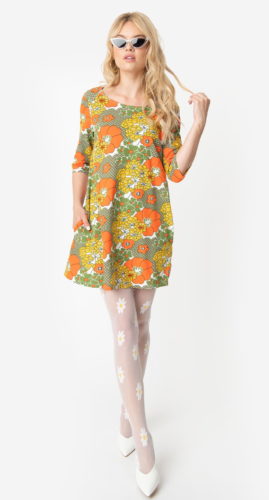
60s-70s Flower Ability Dress with Daisey Tights. Store here.
Paisley
The bright psychedelic colors were great for summer but out of place in the autumn. The solution was the paisley impress.
The paisley print in earth tone colors of moss light-green, brown, mustard yellow, deep blue, and burnt orange were common colors in the absurd seasons. They allowed women to dress in the bold patterns they already loved but on a toned-down, office friendly, scale.
Paisley was also worn in summertime in light pastels and trippy psychedelics.
Shop 1960s Style Dresses
To complete your look, add a pair of 1960s apartment shoes and colorful jewelry. For all you lot dress makers, await at these 1960s reproduction sewing patterns.
0 Response to "S L Fashions Women's Black Dress Rhinestones Shoulders"
Post a Comment